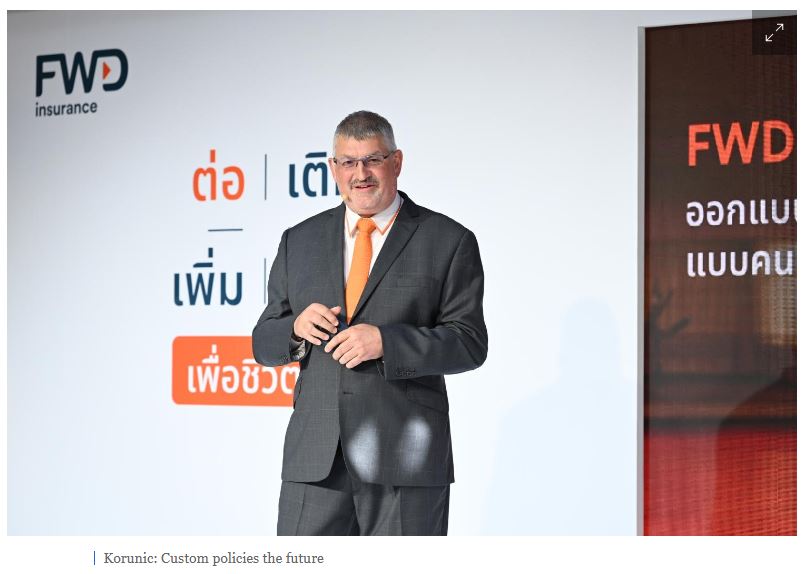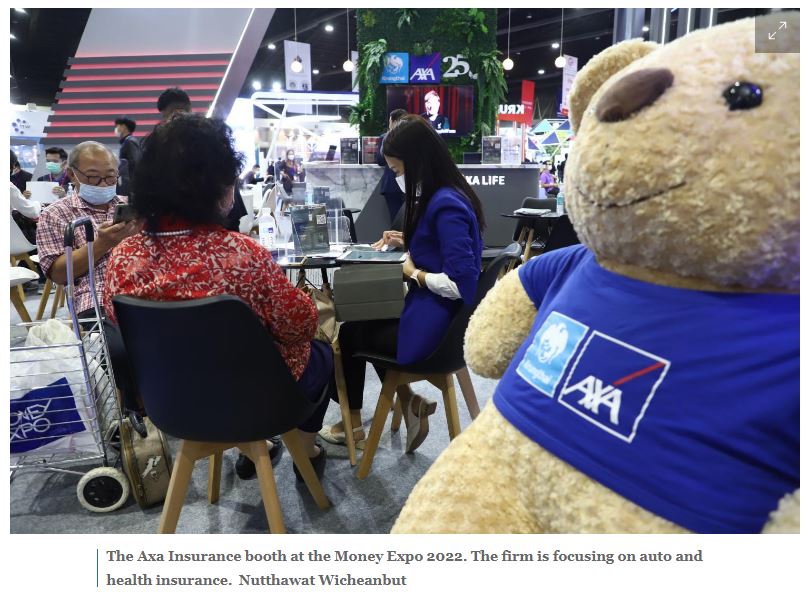Thailand: Incremental growth
The local insurance industry posted continuous growth over the past decade, reflecting increasing consumer demand and awareness of the importance and benefits of insurance in protecting their well-being.
SINGLE-DIGIT GROWTH
According to the Thai Life Assurance Association (TLAA), the industry is expected to post 0-2% growth in gross written premiums (GWP) this year, while first-year premiums are forecast to expand at a rate of 2-5%.
Nikhil Advani, chief executive of AIA Thailand, described 2023 as a “transition year” for the industry, in which new challenges arise.
“Most people want to go out and live a normal life. At the same time, they still have concerns about the state of the economy and possible uncertainties that could happen,” he told the Bangkok Post.
Most insurance executives remain optimistic the industry will expand this year as consumers are more health-conscious following the pandemic.
“We are entering a world that is full of uncertainties. This will make people pay more attention to risk management through insurance,” said Amorn Thongthew, managing director of non-life insurer Viriyah Insurance.
According to data from the Office of the Insurance Commission, total direct premiums for non-life insurance reached 274 billion baht last year, expanding from 262 billion in 2021.
TLAA president Sara Lamsam said positive factors that could help the insurance business this year include the recovery in tourism and the interest rate policy of the US Federal Reserve.
 “The insurance business has faced a cycle of rising and falling interest rates for a long time,” said Mr Sara, also chief executive of Muang Thai Life Assurance (MTL). “It depends on how insurance companies manage their investments and insurance models to fit the global situation.”
“The insurance business has faced a cycle of rising and falling interest rates for a long time,” said Mr Sara, also chief executive of Muang Thai Life Assurance (MTL). “It depends on how insurance companies manage their investments and insurance models to fit the global situation.”
Commenting on the outlook this year, Chaiyapol Inthuprabha, senior vice-president for corporate strategy and planning at Bangkok Life Assurance (BLA), said insurers can now launch new products with attractive returns as interest rates rise.
On a regional level, health and life insurer Prudential Plc said the lifting of Covid-related restrictions across Asia-Pacific and the reopening of China signalled the year is starting well, with encouraging progress in year-on-year sales for the business.
“In Hong Kong there has been a gradual increase in cross-border traffic from the Chinese mainland as travel restrictions are eased. Demand for savings products across Hong Kong’s business sector is driving the increase in annual premium equivalent sales in the first two months of 2023,” said Prudential chief executive Anil Wadhwani.
“We also see large growth opportunities in Southeast Asia, particularly in Indonesia and Thailand, as well as India.”
OUTSTANDING SEGMENTS
Firms agree health insurance is expected to see the most outstanding growth this year.
According to AIA, health insurance products, including plans that cover critical illnesses, will continue to grow as there is increasing demand among Thai consumers who need health coverage to deal with unexpected risks.
Mr Sara of MTL said health insurance premiums only account for a small portion of the total compared with past years when premiums mostly came from endowment life insurance.
Last year, the total premiums of health and critical illness insurance surged 9.5% year-on-year to 27.1 billion baht, accounting for 18.1% of all segments.
TLAA reported as medical expenses continue to increase every year, people are becoming more aware of managing that risk.
“Trends for healthy lifestyles are emerging. More consumers are looking to make healthcare plans that will give them a sense of stability,” Mr Sara said.
“We also see growing premiums from unit-linked products as well as universal life in the future.”
The association said the insurance business can expand further as the penetration rate was only 3.8% in 2021. Factors that encourage industry growth include tax benefits for policyholders and related regulations, according to TLAA.
 “The rising interest rate is boosting the attractiveness of endowment products, while the increase in healthcare expenditure and health awareness will lift demand for health insurance,” said Mr Chaiyapol, adding BLA targets double-digit growth in new business premiums in 2023.
“The rising interest rate is boosting the attractiveness of endowment products, while the increase in healthcare expenditure and health awareness will lift demand for health insurance,” said Mr Chaiyapol, adding BLA targets double-digit growth in new business premiums in 2023.
For Axa Insurance, auto insurance will be the focus along with health insurance.
The local unit of France-based global insurer Axa Group launched late last year Thailand’s first insurance policy tailored to the specific needs of electric vehicle (EV) owners, as well as motorists looking for a more environmentally-friendly lifestyle.
With a starting price of 19,000 baht, the coverage includes accidental damage or loss of a charging cable (up to 10,000 baht per policy), accidental damage or loss of a home charger (up to 50,000 baht per policy), and third-party liability for the use of home chargers and public EV charging stations (up to 1 million baht per accident).
Expecting substantial growth of EV sales in Thailand, Axa priced its EV insurance 20-50% higher than conventional auto policies.
PERSONALISED COVERAGE
Insurance companies have been competing to offer packages that appeal to Thai consumers, with customer-centric products and personalised plans prevalent themes this year.
 Mr Advani said AIA will continue to focus on its “customer centricity” strategy, using market research to serve the needs of customers related to technology and the economy.
Mr Advani said AIA will continue to focus on its “customer centricity” strategy, using market research to serve the needs of customers related to technology and the economy.
“The concept for our product development this year will shift,” he said.
“Our company views insurance as not only a product, but also a solution that can offer consumers full protection of their life and health.”
Similarly, FWD Insurance adopted a customer-centric strategy with an aim to change consumers’ perspective on life insurance.
The FWD Modular Series allows policyholders to have joint coverage with their family members and tailor plans to suit their needs.
 David Korunic, chief executive of FWD, said a one-size-fits-all insurance product is no longer useful for customers as they are increasingly inclined to look for more versatile and flexible insurance policies.
David Korunic, chief executive of FWD, said a one-size-fits-all insurance product is no longer useful for customers as they are increasingly inclined to look for more versatile and flexible insurance policies.
The customised insurance model is also reflected in Prudential’s strategy. The company will focus on bancassurance, citing Thailand’s well-developed financial services industry, said Mr Wadhwani.
“In Thailand, we continue to refresh our product suite to address the evolving needs of the Thai population’s health and wealth aspirations,” he said.
“We completed the integration of our bancassurance capabilities with TMBThanachart Bank, including training their staff on our products and propositions.”
In addition, many insurance firms are integrating artificial intelligence technology including digitalisation into both solutions and product development to achieve efficiency. For instance, Viriyah is set to design a variety of products that cover all types of risks and meet the needs of consumers.
“Using data-driven innovation, we can conduct a deeper analysis of market research,” said Mr Amorn.
“This year, we will survey consumers’ needs in each region for health and non-life insurance to build a personalisation model that offers unique and individual coverage.”
 INDUSTRY RECAP
INDUSTRY RECAP
TLAA data indicates total insurance premiums rose steadily from 2012 to 2018. The tally dipped slightly in 2019 and 2020 before regaining momentum in 2021, with total premiums exceeding 614 billion baht, up 2.3% from the previous year.
In 2022, GWP during the first quarter totalled 150 billion baht, edging down 1.8% year-on-year. New business premiums, meanwhile, fell 6.1% year-on-year to 40.9 billion baht.
The digital channel registered the highest sales growth, surging 35.1% to 205 million baht.
Premiums gained from sales agents rose 5.3% year-on-year to 73.5 billion baht.
The second-largest sales channel was bancassurance, with premiums totalling 61.3 billion baht, down 9.1% from the same period last year.
Mr Sara said the insurance business was sluggish during the first quarter of 2022, attributed to economic headwinds, including high market volatility and geopolitical tensions.
For the full year in 2022, total premiums in the market contracted 0.45%, missing the market estimate of 0-2.5% growth.
“The past year was full of challenges as the pandemic and the economy lowered the purchasing power of consumers substantially,” he said.
Source: https://www.bangkokpost.com/business/2541929/incremental-growth


 Thailand
Thailand




